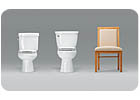
I bet you wouldn't think of Christy Brinkley as some old fuddy-duddy who needs a grab bar to safely get in and out of the shower every morning. And if she did, you wouldn't expect her to grab for anything remotely unfashionable.
Well, the former supermodel turned 52 this year and is just one of a huge number of aging baby boomers just beginning to reshape the homebuilding and remodeling industries as they enter their version of the golden years.
Baby boomers like Brinkley - some 77 million strong - have influenced American life since they were in the cradle, taking what might have been niche markets and, thanks to their sheer numbers, turning those into mass markets along the way. As the boomers enter their 50s and 60s, the latest niche-turned-mass market this bunch currently represents is dubbed the “aging-in-place” market.
“People want to live in houses, not institutions,” said William Owens, president of Owens Construction, Columbus, Ohio, during one of the 2006 International Builders Show's seminars on the 50-plus market. “The idea of aging-in-place homes is that you can't tell it's for the aging.”
Basically, aging in place means just what you think: enabling people to remain in their homes as long as possible, regardless of physical challenges bound to come with advancing age. In other words, they want their homes to grow old as gracefully as they intend to. Homebuilders are beginning to address these concerns (see sidebar “Aging-In-Place Already In Place In New Construction”), and, from the sound of a few seminars at IBS, remodelers will be busy for years to come.
“With baby boomers going into the retirement years, they are key to growth in the construction industry,” said William Apgar, from Harvard University's Joint Center for Housing Studies. “Half of all residential remodeling done in 2005 was completed by baby boomers.” Apgar put last year's total remodeling tally at $230 billion, with residential remodeling accounting for 40 percent.
For our slice of the construction industry that means making the bathroom easier to navigate safely. Take slippery floors and hard, porcelain surfaces, then add the most bending and reaching we're likely to do for the day, and the bathroom can be the most dangerous room in the house. Nobody wants to go to a nursing home, but restricted physical capabilities for such everyday routines as bathing and using the toilet unassisted are common reasons that force them there.
Making the room safer can include plenty of products ranging from large faucet handles, adjustable showerheads and grab bars, to transfer seats, bath chairs, wall-mounted sinks and elevated toilets.
However, the last thing a baby boomer wants are bathroom fixtures and fittings that look remotely like they belong in a hospital. Don't expect this crowd to accept anything for an “old person” - especially when they become old people. Boomers envision a much more active version of old age than their parents could have ever imagined. (See sidebar, “New Attitudes, New Lifestyles.”)
They want to age in place in style. As a result, plumbing manufacturers have developed functional and fashionable ways to do so.
Last year, Moen came out with a new line of Home Care bath-assist products developed largely from a survey done by the company and its bath accessories division, Creative Specialties International. The survey gathered information from men and women, most 55 years or older, who use at least one such assisted device.
While safety was the primary reason to use bath-assist products, users still wanted comfort and style. Since these products are part of a user's daily life, more rounded contours and softer, warmer materials were valued. Respondents also gave high marks for the prospect of colors and shapes that worked with the décor of the bathroom.
At IBS, Sterling's new line of Ensemble shower receptor designs turn a standard 5-ft. bath alcove easily into a stand-alone shower. “Individuals gain substantially more area for cleansing than a standard bath,” said Bill Pavilonis, marketing manager for Sterling's bathing and showering products, “while maintaining the existing floor print.”
While the retrofit receptors will work for anyone who'd rather take a shower than a bath, older users will obviously appreciate the safety of getting in and out of the lower step than a tub/shower combination.
This kind of flexibility with one product that can address the needs of many typifies a similar approach to adapting products for “universal design.” Aging in place isn't that much different from this trend we've written about in the past. The concept of universal design certainly improves the living spaces of the disabled, but does so by optimizing the living space for every family member, regardless of age or ability.
“Designers are no longer focusing on products that address specific physical or cognitive limitation,” said Mary Jo Peterson, Mary Jo Peterson Inc., Brookfield, Conn., who is a frequent speaker on universal design. “Instead, designers are developing products that work better and more easily - and look beautiful, too - and enhance everyone's lifestyle. It has to function well and look good.”
In this case, plenty of existing plumbing products would work for aging in place just as well as universal design. Wall-mounted sinks, for example, look great, but also accommodate a wheelchair. And while blade faucet handles would help older people turn on the water, any number of flat handles can just as easily operate with the same push and pull action - plus make a better fashion statement.

New Attitudes, New Lifestyles
Last year, Business Week wrote a cover story on how baby boomers are forcing marketers to look at consumers over the age of 50 - a crowd that most wouldn't have been interested in. Mass marketers train their attention on consumers from 18 to 49, and lose interest in consumers once they pass 50. After that, brand name preferences are locked in and disposable income has been disposed.Marketers, however, are realizing that today's boomers are tomorrow's consumers. For one thing, most consider 50 to be the new 30. Fewer than 20 percent say they will stop working altogether. Instead of viewing work as drudgery, those continuing to work part time say they will do so to stay mentally and physically active. The Bureau of Labor Statistics predicts the share of the 55-and-older age group will increase to almost 20 percent of the labor force by 2012.
As more and more boomers continue to work, Business Week figures the collective wallet will continue to get fatter. People age 50 to 60 represent more than $1 trillion of spending power a year, about double that for people currently age 60 to 70.
Here's some additional research provided by the National Association of Home Builders on the 50-plus market.
Facts About Boomers
- Born between 1946 and 1964
- Largest generation in U.S. history with 77.5 million people.
- Between 3.5 million and 4.4 million will turn 55 every year between now and 2012. The total population of people 55 and over will break 100 million by then.
- Americans 50 and older control more than 75 percent of the nation's wealth and own more than 50 percent of all discretionary income.
- Led by the boomers, the seniors market is the fastest-growing segment of the population.
- Baby boomers make up a third of the population, but own 45 percent of all homes.
- Because people are living longer, the projection is that people will spend 20 to 25 years in retirement as of 2000. That's up from 19.4 years in 1990 and 13.6 years in 1940.
- People 50 and older accounted for more than 342,290 of the expected 1.267 million new home purchases in 2005. They accounted for 1.53 million of the projected 6.15 million sales for existing homes in 2005.
- The active adult market totaled an estimated $51 billion in new home sales in 2005, and those figures are expected to soar in 2006.
- Average income for families ages 55-64 is more than $60,000.
- Average net worth for families in this age group is more than $700,000.

Aging-In-Place Already In Place For New Residential Construction
According to the 2003 National Association of Homebuilders survey of its members, a significant number of builders are already including aging-in-place features in new residential construction:
Sources: 2001 Survey of Consumer Finances, Federal Reserve Board; 2001 American Housing Survey, U.S. Census Bureau and HUD; other U.S. Census data; and the NAHB.
Home Improvement Keeps Improving
We don't know what's better: aging homeowners or aging homes. The current housing boom masks another housing boom that took place in the 1970s, according to Bruce A. Carbonari, president and CEO of Fortune Brands Home & Hardware.“Those 30-year-old homes are ready for remodeling,” Carbonari said during a press breakfast held at the company's booth one morning of the International Builders Show. The aging stock of existing homes was just one of the trends Carbonari, who was president of Moen Inc. from 1990 to 1997, and other Fortune executives discussed the future of the homebuilding and remodeling industry.
Don't Forget The Kids: Baby boomers wield considerable spending power, but right behind them is Generation Y and Generation X, a nebulous group of consumers basically ranging in age currently from early-20s to 30s.
- Members of Generation X and Y have much different expectations about products and customer service. They want to learn, plan and shop online. They expect to be able to customize everything they order.
- Younger homeowners see the kitchen area as the nerve center of the home.
- They expect their homes to be flexible as their families grow.
Tapping Into Equity: A rise in home equity has created a new audience of wealthy homeowners, with a propensity toward remodeling and customizing their home as their best investment.
- The repair and remodel market is projected to hit $291.5 billion in 2006.
- Household improvement budgets will rise to $3,796 this year, up 31 percent from 2000 and 42 percent from 1997.
- Half of all “home improvers” will spend more than $2,000, up from 39 percent three years ago. In addition, households with income of $50,000 or more will spend $4,267 this year, up 12 percent from 2000.
- Homeowners tackled some $275 billion worth of home improvement and repair projects in 2005. In 2004, more than 6 percent of homeowner spent at least $20,000 on their projects.